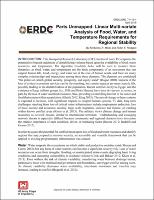Please use this identifier to cite or link to this item:
https://hdl.handle.net/11681/32565Full metadata record
| DC Field | Value | Language |
|---|---|---|
| dc.contributor.author | Miner, Kimberley R. | - |
| dc.contributor.author | Rodgers, Robin E. | - |
| dc.date.accessioned | 2019-04-24T13:48:27Z | - |
| dc.date.available | 2019-04-24T13:48:27Z | - |
| dc.date.issued | 2019-04 | - |
| dc.identifier.govdoc | ERDC/GRL TN-19-1 | - |
| dc.identifier.uri | https://hdl.handle.net/11681/32565 | - |
| dc.identifier.uri | http://dx.doi.org/10.21079/11681/32565 | - |
| dc.description | Technical Note | - |
| dc.description.abstract | This Geospatial Research Laboratory (GRL) technical note (TN) explores the potential to forecast incidences of destabilizing violence based upon the availability of food, water resources, and temperature. The algorithm Livability Index will be used to measure these dynamics, as food, water, and temperature are the basic components of an ecosystem that can support human life. Food, energy, and water are at the core of human needs, and there are many complex relationships and interactions among these three elements. The elements are considered “the pillars on which global security, prosperity, and equity stand” (Hague 2010). Impacts of the loss of critical ecosystem services can be far-reaching, but certain impacts are more acutely felt, possibly leading to the destabilization of the population. Recent conflicts in Syria, Egypt, and the existence of large militant groups (i.e., ISIS and Boko Haram), have been driven into existence, in part, by the loss of water and food resources, thus, providing a controlling interest in the water and food that remain within a population (Gleick 2012; King 2015). The rate of change to these systems is expected to increase, with significant impacts to coupled human systems. To date, long term challenges resulting from loss of critical water infrastructure include employment reduction, loss of basic income and economic security, large scale migration, violence and famine, all existing within known conflict areas (Kloos et al. 2013). The military views climate change and human insecurity as network threats, similar to international terrorism. Understanding and assuaging network threats is especially difficult because community and regional characteristics determine the relative importance of each condition, driver, or mediating factor (Butzer 2012; Redclift and Grasso 2015). In order to assess the potential for conflict based upon loss of food and water resources and identify regions that may jeopardize mission security, an accessible and versatile framework that can be applied to existing programmatic infrastructure was created. | en_US |
| dc.format.extent | 7 pages / 630.9 Kb | - |
| dc.format.medium | PDF/A | - |
| dc.language.iso | en_US | en_US |
| dc.publisher | Geospatial Research Laboratory (U.S.) | en_US |
| dc.publisher | Environmental Research and Development Program (U.S.) | - |
| dc.relation.ispartofseries | Technical Note (Environmental Research and Development Program (U.S.));no. ERDC/GRL TN-19-1 | - |
| dc.rights | Approved for Public Release; Distribution is Unlimited | - |
| dc.source | This Digital Resource was created in Microsoft Word and Adobe Acrobat | - |
| dc.subject | War--Forecasting | en_US |
| dc.subject | Food supply | en_US |
| dc.subject | Water-supply | en_US |
| dc.subject | Temperature | en_US |
| dc.title | Parts unmapped : linear multi-variate analysis of food, water, and temperature requirements for regional stability | en_US |
| dc.type | Report | en_US |
| Appears in Collections: | Technical Note | |
Files in This Item:
| File | Description | Size | Format | |
|---|---|---|---|---|
| ERDC-GRL TN-19-1.pdf | 630.95 kB | Adobe PDF |  View/Open |